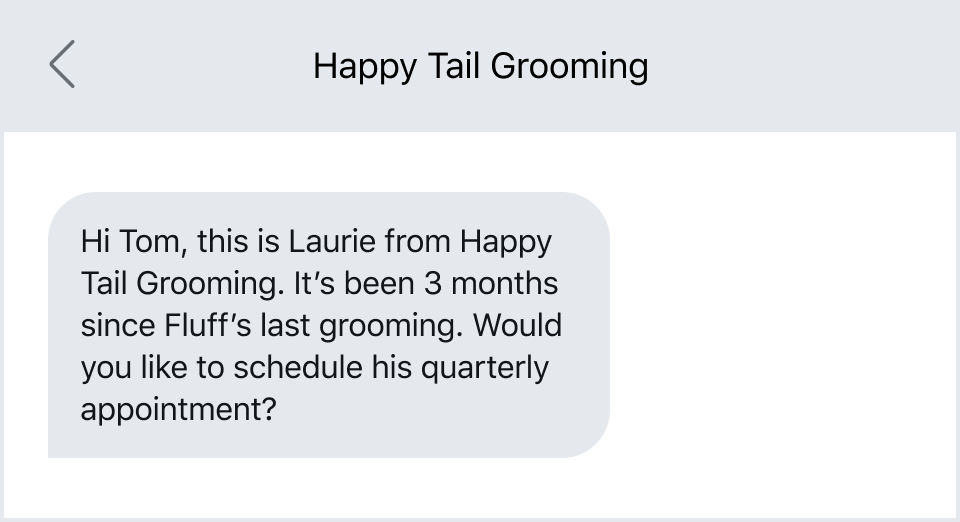Whether you’re an e-commerce business, a local hardware store, or a medical practice, business text messaging has the potential to change how you interact with your customers, patients, and even your suppliers or employees. But business texting is most effective when done right. We’ll walk you through determining your business communication goals and the steps to take when writing a business text message.
Business text messages should be clear and to the point, friendly, and used as a two-way form of communication. If you can achieve all of that in your business text messaging, you’ll be attaining your business goals in no time.
Business communication goals
While each company and business owner will have slightly different goals for their communication, those goals almost always have to do with strengthening the business in some way. Likely, you’re either looking to efficiently increase your revenue or to lower your overall costs.
Those business goals might be accomplished through outbound business communication, like getting higher response rates in order to drive more lead conversions, or proactively confirming appointments to reduce the number of no shows you have. Or they could be inbound communication goals like providing convenient channels for your customers to contact you, improving the customer experience by offering customers a convenient way to contact you.


The reality of business communication is that it’s getting more difficult to break through the noise. The average American makes or receives six phone calls a day. The average open rate for email campaigns is just 21.33 percent and the average click rate for those emails is a fraction of that, at just 2.62 percent, according to Mailchimp. If your communication goal depends on your customers actually reading what you send them, email might not be the way to go.
A more effective way to reach your customers would be with business texting. But business texting can be used for more than contacting your customers, it can be used to communicate with employees as well. Whether you’re using business texting for business-to-business, also called B2B, business-to-consumer (B2C), or even communicating with your own staff, many of the same principles will apply to writing an effective business text.
What makes business texting unique?
Text messaging offers an immediacy and ease that you won’t get with emailing or making phone calls. Like we mentioned, only about 20 percent of emails are opened, and a fraction of those get a click. Additionally, phone calls can be inconvenient, if the recipient is unable to answer during the time of the call and if you leave a message, there’s no guarantee you’ll get a call back. Texting on the other hand, leaves space for the recipient to answer when they have the time to.
Texting allows you to reach your customers, vendors, or team in a way that they’re comfortable with and completely accustomed to. You’re reaching them in a personal and simple way that can feel more convenient and comes with less pressure than a phone call might. While email is also a comfortable medium to communicate in, it’s not as immediate, and remember those poor open rates and click-through rates.
6 steps to writing the best business text
If you’re going to be using business texting to communicate with your customers and employees, there are some general rules to follow to write the most effective texts possible. Keep in mind that the general guidelines of what makes for good business texting apply to texts you’re sending for any business reason.
Step 1: Decide on your communication goal
Before you get to actually crafting a text, make sure you know why you’re sending a business text in the first place. You can think of this “why” as the goal of your business text message. In most cases, if you’re texting a customer it’s likely because you’re trying to get in touch with them for one reason or another.
That reason might be that they’re a new customer you just closed and you want to do an introduction, or maybe you’re checking in to make sure they’re satisfied with a recent purchase, or even reminding a patient that they’re due for their next appointment.
This end goal might be to get a response, to ensure customer satisfaction, or to offer a solution. If you’re texting with your own employees, a contractor worker, or field worker, the goal might be to sort out logistics, or set a schedule. Once you define the communication goal, you’re ready to move on to step two: tone.
Step 2: Choose a tone to communicate in, keep it friendly
The tone of your business messaging should align with your business communication goal, your brand, and who you’re communicating with. While business texting is an immediate form of communication that feels more personal than email, the tone should still be on-brand for your company.
If you’re communicating about legal, medical, or financial business for instance you should be more formal with your communication, meaning you may want to leave the emojis out of these messages. Keeping your messaging on brand might mean being a bit more serious than a retail brand or food services business might be. But taking a serious tone does not mean that your message can’t have a sense of ease to it. Just as you would speak to your customers in a capable, even, and calm tone regarding test results or a new development in a legal case, you want to bring the same ease to a text message.
Consumer brands or retailers have the opportunity to be a bit more relaxed with their messages, almost like they’re talking to an old friend. If you’re one of these brands you could add a bit more fun to the messaging. Emojis, an exclamation point, and a friendly tone are all features of the example message below. Overall, we recommend being clear and friendly. Ideally, your customer, vendor, or employee should read your text and know who it’s from, why you’re texting them, and if they should respond.

Step 3: Introduce yourself
Always introduce yourself and your business when using business texting so the recipients know who the message is from. If you know the customer's name, include that in the message as well to give your response rate a boost.
If you’re texting your employees you likely don’t need to introduce yourself, but you should still be courteous, especially if you’re contacting them outside of their usual work hours.

Step 4: Keep it short and clear
Remember, with texting the expectation is that the message will be short. You can’t just copy and paste your last email to customers and send it as a text instead. Texting is a totally different medium with a different set of rules with it. First, you’re working with a certain number of characters, and you need to get your message across using those specific parameters. Text-only SMS allows for between one and 160 characters. If you go over that 160 in a basic SMS the message will be split up into more than one part, how many exactly depends on the carrier of the recipient. These parameters are all the more reason to quickly get to the “why” of your text message like we mentioned before.
In addition to keeping your message short, it needs to be direct, and ideally clear enough that the recipient won’t have any follow-up questions. Sometimes adding a photo or a link to your text can help illustrate your point better, but it will decrease the character count. Proofread your messages before sending them, rewrite them if necessary to condense the message and quickly communicate your point.
Typos, poor grammar, excessive emojis, multiple links, or incomplete sentences, may make the person on the receiving end think the message is spam, or not legitimate.
You want to make sure your text doesn’t look like the one below.

Step 5: Add relevant attachments or links
You and your recipients can both add photos or links to your messages to illustrate a point or add value to the conversation. Sending photos, or using MMS, of products, work schedules to employees, or even a screenshot for troubleshooting purposes are good examples of what you might want to add.
Links and photos can be extremely useful in two scenarios. First, it’s great for inbound communication from customers or employees who send photos or a link to help illustrate their point or explain something more clearly.

Secondly, they can be used in an outbound manner. Links can drive immediate engagement when sent to a customer who clicks, and they can also be a great way for you to provide customers with more detailed information like a PDF or a graphic.

Step 6: Make it clear that communication is two-way
Your recipients might not know that they can respond and that their message will go to an actual person unless you make that clear to them. This is partially why introducing yourself, and using the customer’s name, can be valuable.
Many of the texts that companies send to their customers are one-way, like order or appointment confirmations. This is another reason it’s so important to let customers know that they can respond. You can do so by telling them clearly, asking them a question, and using a human tone.
Telling them clearly and using a human tone:

Once a customer responds you’ll have their attention and trust along with the opportunity to offer a solution to any problems, or any follow-up information like delivery estimates.
Text messaging with your own employees should also be used as a form of two-way communication. You can use it to let your employees know about new procedures and rules, as well as working on logistics, like checking to see if someone can cover a shift.
Good business text messaging: The bottom line
Most of us are used to texting casually but taking extra care with your business text messaging can go a long way. Remember there are some key steps to take when composing a business text, whether it’s for your customers, employees, or partners. Your business texts should always be grammatically correct, friendly, clear, concise, and two-way.










